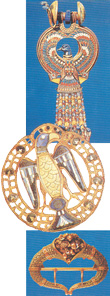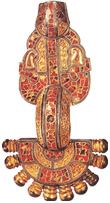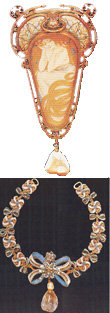|
|
 |
|
Medioeval silver buckle for belts
|
|
 |
|
The enameling can be at night or at day, on flat or not flat support. The enameling at night can also be: on engraving, on modeled, on partition, on grained and on filigreed.
Enameling on engraving. It is known with the french word "chamlever". The engraving can be obtained with the graver or by pressing.
In the finer jewelry the graver is used to create the basin to fill with the enamel, leaving between two colors a thin metallic thread. This undercoat is needed to retain the enameled layer. When it's also necessary to give vivacity to the project, the reflexes get emphasized by using the graining, the arabesques, the "guilloche", and then pass a layer of clear enamel. But it's a very delicate process.
The graining is given by the pressing of a very fine hatch, the arabesques is a chisel work of arabesques, while the guilloche must be chosen depending on the object's destination and it consist in a more or less deep engraving made by graver, in base to the chromatic relief that is wanted on the object
Enameling on modeled. It's practiced only on noble metals and uses exclusively clear enamels. The basin to enamel can be modeled by chisel or pressing. It depends on the thickness the enamel reflexes the light in a different manner: deeper the layer darker the tone. If the relief it develops on a curve space, the enameling is called "at round", a ronde basse in French. This technique was used a lot in the mannerist goldsmith, of which constitutes an important characteristic.
Enameling on partition. It's called "cloisonné", from the French word "cloison" (partition, bulkhead, inner wall), and it requires lots of patience and great ability from the artist. This method consist on setting up the drawing on a flat surface to enamel, or outlined through a metallic thread, obtained by draw or cutting a tile with the shear. The thread goes conveniently shaped so to get the wanted drawing that is afterwards arranged on the metallic layer to enamel. The drawing can be fixed in two ways: or weld it to the thread all around the surface, or fix it only at some points with nailing and dap joint, through fusion of flux (substance capable of facilitating the melting of the metals). The welding can be very small, like a pinhead. The metallic thread can be fixed on a support already covered before by a layer of flux, at which it will stick thanks to the Arabic rubber or to the tragacanth (vegetable glue). It needs to be melted at medium temperature. The thread, as it is fixed, confines with its outline, cavities that will be enameled in all the possible colors.
Filigreed enamel. It's a variety of enameling on partition used in the Renaissance. It became a technique used mainly in Venice, it distinguishes from the enameling on partition because the threads are in filigreed and these are the ones to retain the enamel. Here it cannot be used the finishing in the oven because the border of the filigreed don't perfectly coincide with the enamel layer, so there is a chance to flatten out.
ENAMELING AT DAY. It's called also "a cathedral", it distinguishes from the enameling on partition because the cavities don't have undercoat and the enamel remains fixed only throughout the internal walls. The effect is similar of the stained-glass window. The enamels used are transparent. |
|
|
|
|
PAINTING ON ENAMEL
It affirmed itself in the XVI century and it includes the miniature on enamel. In Limoges the white enamel was preferred as a background. Elsewhere, like in Italy (Lombardy, Veneto) and also in some parts of France, it was used instead the flat blue to show more in relief the painted figures. This job requires an accurate technique, superior to the one of the ordinary enameling, and conspicuous artistic quality. The knowledge of the color use was essential but not sufficient, because the effect of the job has to be mainly artistic, but also of great precision. One of the precautions is to keep the object away from dust and from any foreign substance. That's way it's very important, if the work can't be done in one day, to protect the objects to decorate. Among the painting on enamel it distinguish three different techniques: the watercolor painting, the painting under flux and the Limoges painting.
The watercolor painting is the simplest: the drawing shows by contrast and by the color superimposition on the white enamel background.
The under flux painting is on the other hand similar at the oil painting: the color get mixed so to obtain a relief. The color palette consists of color tones more or less dull, of clear tones and by a white destined to mix at the simple colors or their mixtures.
The Limoges painting is instead a painting with a bass-relief effect made on objects that aren't subject of continuous rubbing: it can't in fact be covered by flux. It is made on clear dark or less dull enamels. The artist uses a brush or the metallic tip or the hard wood tip and uses special semi-clear whites that, based on their thickness, they produce shadows and half tints.
|
|
|
|
|
|
|
|
|
|
ENAMEL DECORATION.
On the enamel can be applied decorative drawing obtained by pure metals, stainless, like silver, gold, platinum, in plates o reduced in very gloss thin layers. To increase the decorative effect it can also be covered by clear enamel. With this method we can imitate the precious stones, filling the cavities with clear enamel conveniently tinted. On the clean and smooth basin, we apply a layer of Arabic rubber or tragacanth: before it dries out, we are will apply the metallic ornament maybe with the help of a wet brush. We can then put the object in the oven with a moderate temperature, sufficient to fix the drawing applied without causing the sinking in the enamel. Then it will be covered with a double layer of flux or with convenient colored enamel, so to obtain particular effect evermore different |
|




